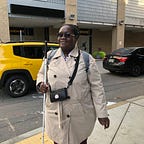By: CaspHer
April 17, 2020
There are going to be challenges for the DeafBlind when it comes to touching objects and people during this pandemic which will feed into additional isolation. Most DeafBlind people experience variations of deafness and blindness. For those who rely completely on touch of persons or things, it would be highly recommended that they keep their hands cleaned and protected at all times as well as their faces. If that is not possible, they would have to avoid people at all costs. When it comes to handling objects; it’s going to be another process of making sure they are able to avoid cross-contamination. I do not believe we would be able to take the new limits of isolation very well. It’s bad enough that we are already isolated within our own DeafBlindness even in large crowds. Some folks are already used to being completely alone while others would have no choice but to adjust.
In my experience as a 30yr old Deaf-Blind woman living in Boston, MA, I would not be severely impacted by the new limits of not being able to touch people or objects. I have some vision and hearing remaining and I am used to being forced to navigate around barriers in life. I’ve been fortunate with the ability to find ways around complications as best as possible. If I cannot touch someone for the use of ASL, I would be able to use “close vision signing” in good lighting. If I cannot touch an object, I would protect my hands with disposable gloves. The coronavirus only forces me to tap into my creative ways for avoiding problems in the long-run. I use various sources of assistive technology for distanced communication. When I want to track my stops on the buses before the outbreak, I would use my braille display with a stop tracking app. The app tracks all stops and routes in real time as we move. I am able to keep the braille on hand and follow as everything moves. Technology for distanced communication is certainly going to replace touching people and objects for the remainder of this virus and beyond.
If a DeafBlind person caught COVID 19 and needed to seek medical attention, there is a high chance that there would be a massive communication barrier. All medical staff would have their faces covered by masks and most DeafBlind people read lips if hearing voices are difficult. If someone still has hearing and uses amplification devices, it would be best for medical staff to speak louder and clearly if an interpreter is not going to be available. Medical treatment would be critically slower for all parties.
As far as programs to assist the DeafBlind, there is a nationwide equipment distribution program known as “ICC” which stands for “ICanConnect” for the DeafBlind. ICC is covered by the FCC which allows anyone living with blindness and deafness to receive distanced communication electronics such as phones and computers and the such to communicate with anyone they wish.
If a deafblind individual needed to visit the hospital for any reason and communication is severely limited, there may be a few work arounds. There are a few apps that are accessible to those who use braille devices. The first app is called, “Ava” and it is a transcription app that translates spoken English into a written format which can be used with a braille display. Ava can be used on both iOS and Android devices. The second app is called, “BuzzCards” from Sorenson VRS for iOS and Android. BuzzCards is basically a communication app that can be used to request or communicate. I use all of the above for different situations.
I am an assistive technology trainer for the blind and visually impaired in Boston and this pandemic has side-swiped my ability to teach anyone face to face. I currently have to train my students remotely and that is a longer process for both me and my students. I communicate with a variation of methods. I use American Sign Language as well as voice. I read braille and blindness related technologies. I use a Bluetooth hearing aid that is able to connect to my iPhone for streaming media if needed. I used to be able to use SSPs and ASL interpreters for organized events but I cannot do that anymore because of COVID-19. I now have to strategize around the complete lack of help, completing outdoor tasks take much longer. If I cannot find what I am looking for, I end up going home without it. I leave because I am afraid of someone coming near and possibly spreading the Coronavirus to me without knowing.
My main concern for the DeafBlind people who end up needing medical attention would be the ability to communicate properly with the medical staff. I fear that the medical staff would not know the best practices for helping DeafBlind. Their faces are covered in masks and they are not able to touch the patient or their electronics to relay any communication back and forth.
It’s hard enough helping someone who is either deaf or blind. If you are Deaf, there may not be an interpreter available or the CART services may not work properly. If it is a blind person who ends up in the hospital, most staff are strangely uncomfortable with the thought of helping a blind person. The biggest challenge is helping someone who has a combination of blindness and deafness. Honestly, I hope I would not have to visit the hospital because of COVID 19 or during the pandemic. I sincerely hope no Deaf Blind person would have to be in the medical facility during this disaster at all.
Photo Description:
CaspHer standing in front of an Avenue Plus-Size modeling billboard wearing black leather pants, aviators and a crisp white shirt. She is facing the right and striking a pose with her own electric guitar for photo props.
